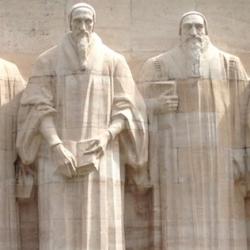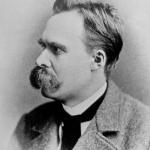In a 1971 essay, H.G. Koenigsberger challenged the notion that the Reformation broke up a unified Europe. He criticizes historians and social scientists for assuming a norm of unity: “We have assumed that the theological and ecclesiastical unity of Catholic Christendom was its natural condition and that, in consequence, the Reformation was a dramatic break in this condition which ran counter to all previous Christian experience and which, in a sense, destroyed the natural order of things.”
Much of the essay presents an analysis of the kind of unity that existed in pre-Reformation Europe. Koenigsberger poses the question this way: “For the thousand years of the Middle Ages, Christendom and its institutions remained obstinately divided, and Christians remained distressingly prone to engage in deadly wars with each other. Why was it that only the Church survived as a unified institution?”
His first answer is sardonic: “it did not do so. Throughout the Middle Ages there existed Christian churches in Africa and Asia which were never in communion with Rome at all.”
The more elaborate answer answer is that “medieval unity, insofar as it existed, was a function of an economically poor society. The small surpluses of production of any given area would not be wanted in the adjoining area, which was probably producing the same commodities, but rather in much more distant areas. Medieval trade was, therefore, small in volume but covered large distances.”
Craft skills were specialized and scarce, and thus craftsmen had to be mobile: “Bell founding was a highly skilled and specialized craft. After a master founder had cast the three or four, or even six or eight, bells for the church of a small town, he would have to move on, for there would be no further work for him in this town nor, very likely, in the neighbouring towns. It was the same with all other skills, from the cathedral builder to the learned scholar, from the forger of fine weapons . . . . Different areas of Europe might advance in certain skills, as Flanders did in the weaving of fine cloth; but no single area of Europe could support all of the skills which European society required. Only the whole of Europe could do this.”
Cultural unity thus depended on a “thin crust of men highly skilled in the production of sophisticated commodities or in the performance of complex services. This upper crust was international in education, attitudes, and often, physical mobility; for this was the only way it could function.” Cultural unity depended on a low rate of entry into this upper crust. European unity was a unity of the “1%.”
The work of the church was was one of the skilled forms of labor that could only be performed by members of the “thin crust”: “Functionally speaking, [the church] represented a highly specialized skill, but one that was needed in every part of Christendom, and it had inherited, from Roman times, the traditions and institutions to use these skills most effectively on an international level: the common dogma, the common script and language, the admirably flexible hierarchical organization.”
The elites of trade, craft, and church were successful, and between the tenth and fourteenth century “Christian Europe grew enormously in population and wealth.” That success, though, created conditions for more men to enter the elite. By the high Middle Ages “different parts of Europe had become sufficiently wealthy to be able to afford more and more of the specialized skills they required.” A town that wanted to build a cathedral no longer had to hire craftsmen and skilled labor from another area of Europe; they could put their own educated and skilled craftsmen to work. And that produced more local and regional variation. Koenigsberger notes that “the Gothic style of architecture and art, while still international, shows far greater regional variation than does the Romanesque.” Similarly, as more universities were founded by kings and city governments, intellectual elites became less international: “Soon there would be laws prohibiting students from attending universities outside their rulers’ dominions.”
Like every other institution in medieval Europe, the church went through this process of regionalization and localization: “In the eleventh and twelfth centuries it had been considered perfectly natural for Italians, such as Anselm and Lanfranc, to become archbishops of Canterbury, or for an Anglo-Norman cleric to hold the see of Palermo.” But by the thirteenth century, “such an international interchange had become almost inconceivable.”
Signs of centrifugal forces are evident throughout the centuries leading up to the Reformation – reforming movements within the church, sometimes breaking free into independent movements; rival papacies, with kings taking sides, anticipating the anti-papalism of their sixteenth-century Protestant counterparts. The conciliar movement tried to arrest this process but “the defeat of this movement, and the subsequent concentration of papal energies on Italian power politics made it virtually impossible for the Church to adapt itself to the changing conditions of European Society.”
Koenigsberger acknowledges that the Reformation broke the camel’s back, but sees it as the culmination of several centuries of mounting instability. He identifies two factors that made the sixteenth century decisive in this process: “the increasing political tension between the monarchies and the papacy over the question of the control of the institution of the Church and its personnel in the different countries of Europe; and the spread of the printing presses, which made the Bible available to the Christian laity and thus undermined the claim of the Church to act as the indispensable intermediary between God and man.”
It is a fascinating thesis, and dispels romanticized notions of medieval unity. Koenigsberger writes as an historian, but his claim that there is no past of blissful unity is theologically sound too: Unity is the future reality of the church, as we grow up into the one new man that we already are. Still, I register a fundamental reservation about his claims: For Koenigsberger, scarcity and skill and other economic factors are the driving forces of medieval history (perhaps of all history?). Important as those factors are, the cause-and-effect should be inverted. Economics isn’t the heart of the story. The heart of the story is about Jesus and His church, and what happens there is decisive.
(Koenigsberger, “The Unity of the Church and the Reformation,” The Journal of Interdisciplinary History 1:3 [Spring, 1971]: 407-417.)














